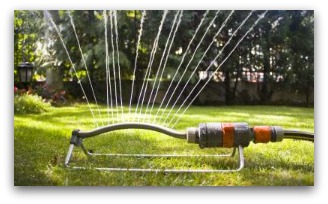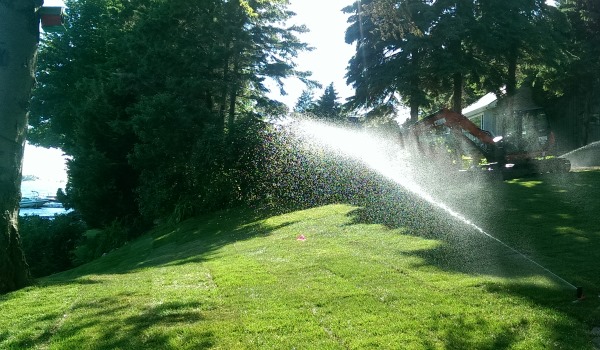A. Watering Lawn
You would think that watering lawn would be a pretty simple task? The truth is, there is much controversy over how much, and what is the best time to water a lawn?
So how much water should I be giving my lawn?
This short module will take a look at some basics of watering lawn. We want you to have a great lawn, and efficient watering is just one more way to get there.
If you are watering new grass or newly seeded lawns, I suggest you visit our modules on seeding and sodding for some important tips.
These require some special attention until the are established.
I think it's important not to give you a schedule, but to be in tune to variables.
Variables will change the requirements of water you need on a daily basis.
Most lawns will require at least one inch of water per week, but with bluegrass and ryegrass it could be up to 2 or 2 ½ in hotter summer months.
You need water to survive, right?
Do you drink a measured amount of water on a schedule? A doctor may tell you to drink so many glasses of water a day, but that is only a guideline.
What if you are running on a hot day in the summer?
You will require considerably more in this case. If you are at rest for the day, you will require less.
Your lawn is a living thing just like your body, and requirements for watering lawn can change from day to day.
Don't waste water by giving it more than it needs, or by leaving on irrigation systems during heavy rains. Give your lawn only what it requires.
Soil
It helps to understand your soil and its drainage qualities. If you have a heavy clay soil, it will take considerably longer to water to a depth of six inches than loam, or sandy soil.
Sandy soil drains quickly and can be soaked to the same depth as clay soil with about a quarter of the amount of water. You will have to water sandy soil more frequently, because it will dry out rather quickly.
Rich loam falls in between the two, and holds moisture rather well. If you have very poor soil please visit our sections on aerating and topdressing. These things can help you improve your existing lawn without having to start over.
When to Water
Watering lawn in the morning or evening can be a controversial subject. The morning is the most accepted time before the intense effects of the sun and heat arrive.
Watering lawn at night allows the lawn to stay wet for longer periods of time. Many claims have been made that this time also creates a more favourable environment for mushrooms and diseases.
We are not disputing that this is true. But, after living in a climate where we had weeks of rain at a time, none of this was the case with my lawn. If you have good soil and drainage, watering at night is completely acceptable, and many people do it. Lawn sprinklers should not be left on overnight, as this wastes water.
Watering grass in late afternoon or early evening is peak water consumption time (between the hours of 4pm to 9 pm).
This is discouraged by most cities. Watering lawn when it is hot, dry, or windy days is also discouraged. You will lose a percentage of the water through evaporation making it a waste of time and water.
Watering lawns during a light sprinkle is also acceptable. It is ok to combine your efforts with rainwater, if you have an idea of how much you may be getting.
You will use less water to achieve a good soaking. Watering in a heavy rain is pointless.
One method that people use to determine if water is needed is called “footprinting”. When you step on your lawn the grass will lay down where you stepped. If the grass stands up or recovers within an hour or so, it is fine. If it stays down, then you will need to water it.
You can also probe the soil if you are unsure of whether or not it needs water. Dig down in the soil, or sink a screwdriver into it to check for moisture. If it is dry, then you need to water it. You can also check with your local garden center for soil probes, or other devices that aid in efficient watering practices.
Most lawns need a minimum of about one inch per week so. Some people will place cat food or similar cans at various places in their yard. (If you can find a can that is 1 inch deep, perfect.) When the cans have received an inch or so of water, then stop watering. This is a pretty simple method, but it does work.
How Much Water?
You will hear “water deeply and infrequently”. Everybody says it, but they don't always explain it. This is called “training your lawn”.
Try to water the soil to a depth of six inches, then allow it to dry out. This will train your roots to grow deeper into the soil, making your lawn healthier and more drought tolerant. Watering frequently to shallower depths, can lead to a shallow root system that is more dependent on your watering. This can also lead to increased thatch.
Deeper root system = Healthier, more tolerant lawn.
Water runoff - This is when the soil will not soak up the water fast enough for the amount you are giving it. This can happen with clay soils very easily. In this case, try to conserve water rather than watch it run off your lawn and down the street.
Water for 10 to 15 minutes, then shut off the water for 20 or 30 minutes and turn it on again. You may have to do this two or three times with heavy clay soil to allow the water to soak deep enough. If you have a lawn sprinkler, just move it around every 15 to 30 minutes in a cycle to go over the yard two or three times.
A couple of times a week should be plenty of water if you are watering deeply and infrequently. We mentioned that conditions can vary, so be in tune to your lawn. Slopes have a harder time retaining moisture and may require more frequent watering.
Shady areas generally require less water, except grassy areas around tree root systems. The grass and tree compete for the water, so you may have to water these areas more.
It is also becoming more popular to let your lawn go dormant in the hottest months of the year. This is being environmentally, and budget conscious. Without proper irrigation, it usually ends up being a losing battle.
Your lawn will turn brown and go dormant to protect itself. This is normal, and it will come back when the moisture and temperatures are more favourable. Decide before the hottest season whether or not you are going to water it regularly or let it go dormant. ON and off watering lawn can be stressful on your lawn.
Don't water your lawn heavily after fertilizing. This can wash fertilizer into the water system. If you have applied fertilizer, just give it enough to let it soak into the soil without washing it away.
It's time to move onto...Mowing
_____________________________________
Table of Contents: Lawn Care and Maintenance
Introduction: Lawn Care and Maintenance
A. Watering
B. Mowing
C. Fertilizing
D. Aerating
E. Dethatching
F. Topdressing
______________________________________
Go to "The Yard" Landscaping How-to Modules
Return to the Dream Yard Home Page from Watering LawnCheck out our time and money saving e-book
How to avoid the biggest mistakes made by DIYers, designers, and landscaping companies.
Visitor
Favorites
Giggles 'n' Thoughts







